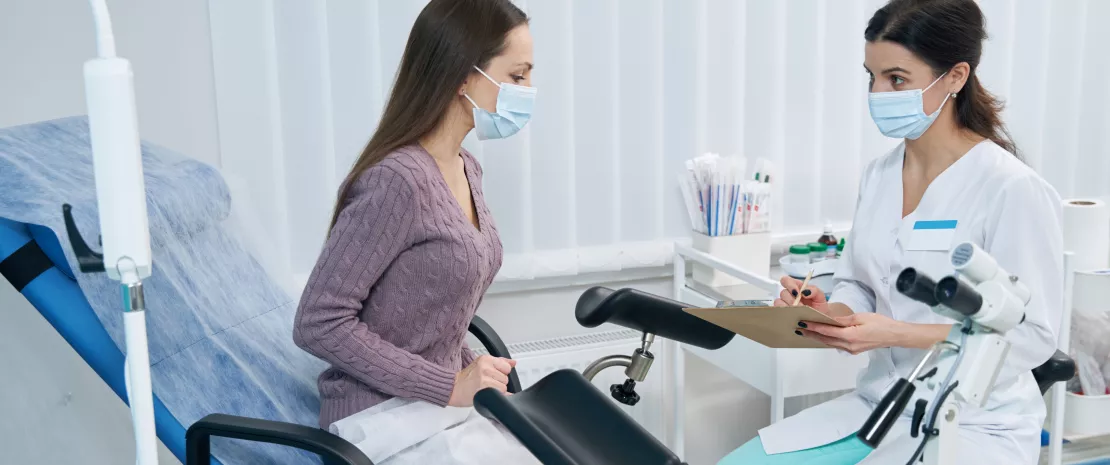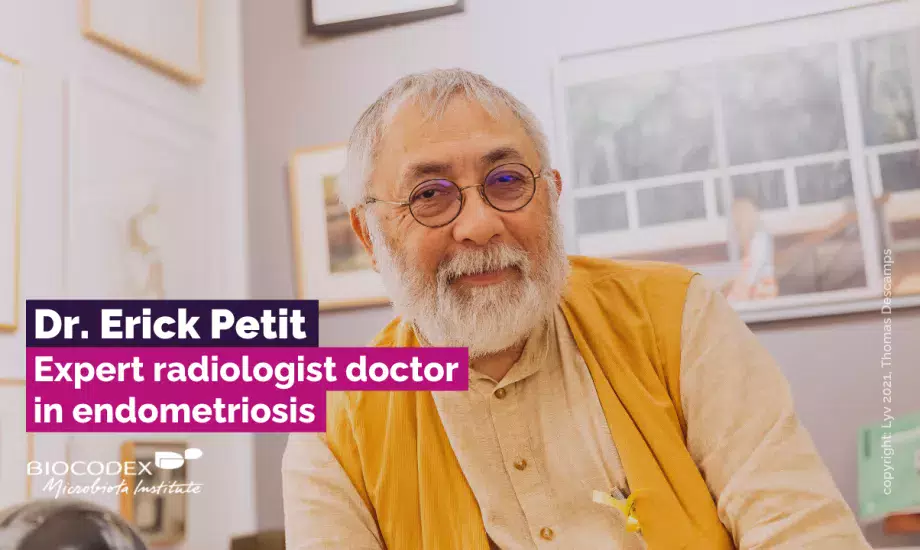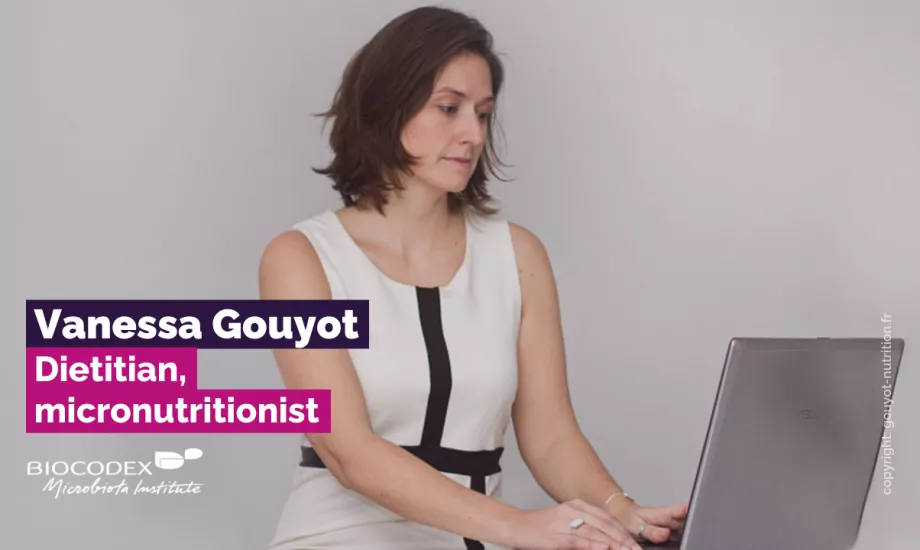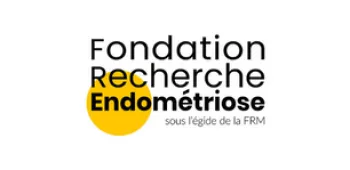Endometriosis and microbiota: is there a link?
To mark Endometriosis Awareness Month, the Microbiota Institute is handing the floor to three experts in this condition. What are the symptoms? How is it diagnosed? What care is available? Is it linked to the microbiota? All your questions answered here.
- Learn all about microbiota
- Microbiota and related conditions
- Act on your microbiota
- Publications
- About the Institute
Healthcare professionals section
Find here your dedicated section
Sources
This article is based on scientific information

About this article
Authors
“Endometriosis: 4,000 years of prejudice and misdiagnosis”
Dr. Erick Petit

Radiologist, founding head of the Endometriosis Center at the Paris St. Joseph Hospital
When was endometriosis first described?
Erick Petit: The disorder has been plaguing the lives of women for 4,000 years... yet it was only recognized as an illness a century and a half ago ! The first officially recorded “patient” was an Egyptian woman in 1855 BC. We can find references to endometriosis as far back as the 6th and 5th centuries BC, posited by Hippocratic physicians who listed the symptoms in detail. After that period, we can observe what appears to have been a kind of medical cover-up. Until the Renaissance, endometriosis was judged to be nothing more than an element of the feminine psyche.
This is supported by the etymology. The word “uterus” originates from the Greek hysterikos and the medical profession was quick to establish the diagnosis of “hysteria”. The illness was seen to be an imaginary condition entirely made up by women, who were actually in agony. It is difficult to believe that it was not until 1860 that the condition was shown to be related to the (sidenote: Endometrium The layer of tissue that lines the uterus. NCI Dictionaries_Endometrium ) , hence the name endometriosis1, by Carl von Rokitansky, a Bohemian pathologist working in Vienna. It is currently estimated that at least one in ten women of reproductive age suffers from endometriosis. It is in fact more likely to be one in seven, or even one in five, women of reproductive age2.
Women disorders
How is endometriosis diagnosed? Why is it so complicated?
E.P.: In reality, the diagnosis is quite simple: patients fill out the clinical questionnaire that I drew up, which is available to them at their appointments in RESENDO (French network). It contains a number of questions, some of which concern the types of pain experienced. I can make a reliable diagnosis based on the results of this questionnaire. The diagnosis is in fact confirmed nine times out of ten. This saves time and is also reassuring for the patient. Today, the way to identify endometriosis is through talking and listening to patients. There are women who have been waiting for a diagnosis for so many years, over a decade in some cases2! They are still victims of prejudices that date back 4,000 years, according to which women’s periods are naturally painful. I have set out to dispel this myth and highlight the fact that endometriosis is a medical condition.
1 in 10 It is currently estimated that at least one in ten women of reproductive age suffers from endometriosis.
10 years There are women who have been waiting for a diagnosis for so many years, over a decade in some cases!
#1 Endometriosis is the number one cause of hypofertility.
The next step, what I would call the gold standard test is, of course, an endovaginal ultrasound carried out by a specialist (or an (sidenote: MRI Magnetic Resonance Imaging. ) for young girls who have never had sexual intercourse, although this technique is less sensitive and less specific). This test shows the lesions and their locations. However, I would like to stress that medical imaging alone is not enough. There is actually no correlation between symptoms and lesions with this illness. This means that some women can have very extensive endometriosis yet hardly suffer, but conversely, others with much milder endometriosis may experience extreme pain.

Do different forms of endometriosis exist? Are some forms more serious than others?
E.P.: There are as many forms as there are patients! This is why it is so important to properly map out their pain to fine-tune the diagnosis and treatment. The main consequence of this illness is infertility, depending on the location of the lesions. We have observed a correlation between the anatomic extent of the condition and fertility. But this is not necessarily linked to pain. Endometriosis is the number one cause of hypofertility!2
What are the early signs?
E.P.: The illness appears after the first menstrual period. A young girl should be carefully observed at this time in order to assess the intensity of the pain, to see if she has to go lie down, if she is not able to attend classes, etc. We know that periods starting early, before the age of 11, represent a risk factor for the illness, as well as having a mother or sister who also suffers from the condition (genetic factors). This is why I campaign for raising awareness about endometriosis among girls aged between 11 and 13. This is the only way to ensure cases are not left undiagnosed. There are also effects on digestion that should not be neglected: the near-majority of my patients suffer from some form of irritable bowel syndrome. It is therefore important to make gastroenterologists aware of the illness!
What is patient care based on?
E.P.: Treatment is still very inadequate and is based on a multidisciplinary approach:
First, hormonal treatment is prescribed (a contraceptive) to counter the main cause of painful periods. By stopping the period, we can stop the pain and halt the progression of the illness.
For the most severe forms, we resort to surgery to remove the endometriosis lesions. Thirty percent of our patients undergo surgery each year.
The third component of treatment addresses pain relief. This can mean prescription drugs, but we also encourage our patients to turn to so-called alternative medicine, such as acupuncture, hypnosis and osteopathy.
Lastly, we can focus on relieving the intestinal pain through nutrition.
“The gut microbiota, undoubtedly a missing piece in the endometriosis puzzle”
Vanessa Gouyot

Dietician with 20 years’ experience
Is there a link between endometriosis and the microbiota?
Vanessa Gouyot: To date, no scientific studies have been conducted that confirm any links between endometriosis and imbalances within the various microbiota (intestinal, vaginal for example) in the human body. However, there are certain clinical signs that support this hypothesis. We now know that 90% of women affected by endometriosis also suffer from associated digestive disorders (irritable bowel syndrome in particular). This figure is borne out in my practice where I am seeing more and more patients who appear to be experiencing gut imbalance, called dysbiosis, in the digestive tract: sometimes oral, sometimes gastric and/or intestinal (sidenote: Dysbiosis Generally defined as an alteration in the composition and function of the microbiota caused by a combination of environmental and individual-specific factors. Levy M, Kolodziejczyk AA, Thaiss CA, et al. Dysbiosis and the immune system. Nat Rev Immunol. 2017;17(4):219-232. ) .
90% of women affected by endometriosis also suffer from associated digestive disorders.
The role of our microbiota is to protect us and form a barrier. But if 90% of women suffering from endometriosis have digestive disorders, that means that there is an associated inflammation of the digestive system... My mission is to enable my patients to understand that the digestive tract is a passage which is permanently under assault (by food and drink, among other things). This aggression may alter the digestive system and lead to inflammation. The human body should be seen as a big emergency response center regularly sending out units to provide aid.
Vanessa Gouyot:
“Progress has been made in research on the microbiota and this will, in time, significantly improve the quality of life of patients with endometriosis who suffer from digestive disorders.”
However, if all the units are dispatched to handle a permanent case of inflammation in the gut, then they cannot respond to all the other alerts. All these alerts form a “background noise” of inflammation, i.e., chronic inflammation, which is thought to facilitate the onset of other conditions, such as endometriosis.
Given the digestive system symptoms observed in patients suffering from endometriosis, could the microbiota help diagnose the illness more quickly?
V.G.: Endometriosis is an inherently complex illness that is particularly difficult to diagnose and should be handled with great humility and some caution. The mechanisms of the illness have inspired numerous hypotheses but it has not yet been possible to determine which is the closest to reality. The role of the microbiota is one hypothesis among many. The fact is that research into the microbiota is moving forward and this is bringing much hope to patients, but we should not get ahead of ourselves. Something to consider is that rather than attempt to assess cases of endometriosis via the microbiota, we could instead assess the microbiota to make a better diagnosis of patients’ bowel inflammation and their digestive disorders3. Endometriosis care requires a global and multidisciplinary approach.
Today, when taking on a new patient suffering from endometriosis, we investigate the finer details of her diet, what she drinks and also her living environment. These are all factors that could prove aggressive to the digestive system and lead to an imbalanced gut microbiota.
The gut microbiota
Could the microbiota be useful in the search for future treatments?
V.G.: Progress has been made in research on the microbiota4,5 and this will, in time, significantly improve the quality of life of patients with endometriosis who suffer from digestive disorders6. In the meantime, as we wait for future medical breakthroughs, taking probiotics remains one way to restore normal gut microbiota function and reduce inflammation. The problem is the lack of information. Some of my patients do not see probiotics as necessary, others take them sporadically, and then others come back to me to say that they do not work.

41% Only 41% of women surveyed say they have taken probiotics and/or prebiotics (either orally or vaginally)
Different cases require specific explanations for each patient. Remember that the context is important when taking probiotics and recommendations from an expert are required. There are very many strains of probiotics that can have beneficial effects on endometriosis. The objective of probiotic therapy is to give our patients the tools to manage their condition, so that they become more attentive to signals from their body and so that they can finally achieve acceptable levels of comfort. Getting them back to a normal life with less pain is the ultimate victory for us.
Probiotics
“Yes, diet can relieve a painful digestive system associated with endometriosis”
Dr. Laetitia Viaud Poubeau

Doctor of medicine, specialized in functional medicine and nutrition
Can a healthy diet help to restore balance to the gut microbiota of women suffering from endometriosis?
Laetitia Viaud Poubeau: In cases of endometriosis, a Mediterranean-type diet, i.e. a diet rich in vegetables, fruits, pulses, and whole grains, but also Omega-3 fatty acids, which are both prebiotics and anti-inflammatory, can only be beneficial to the gut microbiota. A diet like this with anti-inflammatory properties promotes the development of
(sidenote:
Eubiotic flora
A “balanced” flora.
Iebba V, Totino V, Gagliardi A, et al. Eubiosis and dysbiosis: the two sides of the microbiota. New Microbiol. 2016 Jan;39(1):1-12.
)
, rich in bifidobacteria and lactobacilli7-9.There are many benefits to this type of diet: it helps to restore balance to the gut microbiota, combats intestinal permeability effectively and thereby reduces inflammation.
Diet
What foods should be avoided by endometriosis patients?
L. V.-P.: What we refer to as the “Western diet”8,10, a diet rich in processed foodstuffs, refined sugar, salt, saturated fats (red meat for example) and trans fat (such as pastries),11 is particularly bad for the gut microbiota. The Western diet can cause gut dysbiosis that leads to varying levels of complications in the body over time. Strong alcoholic beverages and drinks like sodas, syrups, and fruit juice should also be added to this list of foodstuffs to avoid because they are particularly rich in sugar and/or sweeteners. Some studies also demonstrate the benefits of reducing the amount of gluten in the diet, since it is thought to contribute to the inflammation involved in the illness.8,12,13
On the other hand, opinion is more divided when it comes to the consumption of dairy products. They do not appear to put people at a higher risk of developing endometriosis14,15. The levels of growth hormones that they contain may, however, be conducive to (sidenote: Hyperestrogenism Normal or high levels of estrogen secretion, but which continues for longer than the secretion of progesterone. Norman Lavin (1 April 2009). Manual of Endocrinology and Metabolism. Lippincott Williams & Wilkins. p. 274. ISBN 978-0-7817-6886-3. Retrieved 5 June 2012 ) in patients suffering from endometriosis16. Additionally, hypersensitivity to milk proteins maintains a “background noise” of inflammation8: this means permanent, chronic inflammation.
Additives, antibiotics used in the agri-food industry, endocrine disruptors, pesticides, and other chemical pollutants that we find in our food should also be treated with caution because they can affect the balance of our microbiota.
Foods to be avoided by endometriosis patients
- processed foodstuffs
- refined sugar
- salt
- saturated fat (red meat, etc.)
- trans fat (pastries, etc.)
- sodas, syrups, fruit juice
- strong alcoholic beverages
- reduce gluten intake
What are the consequences of a Western-style diet on the gut microbiota? What are the dietary alternatives?
L. V.-P.: Gut dysbiosis caused by the Western diet will result in intestinal discomfort, which can range from constipation to diarrhea. In many women suffering from endometriosis, we have also observed bloating, intestinal spasms and flatulence that can be odorous to varying degrees.
We then recommend a (sidenote: “Fermentable Oligo- Di- Monosaccharides and Polyols”: Fermentable carbohydrates. ) -free or digestive-sparing diet in order bring quick relief to patients17. The digestive-sparing diet is based on a set of simple dietary and lifestyle rules: excluding raw vegetables, raw fruits, lactose, gluten, irritant beverages like coffee, strong alcohol and sodas, limiting citrus fruits and cruciferous vegetables, etc. It can be followed for 4 to 6 weeks, is less restrictive than the FODMAP-free diet, and above all does not alter the balance of the gut flora18.
In France, throughout the month of March, the Microbiota Institute and the (sidenote: https://www.fondation-endometriose.org/en/homepage/ ) (the foundation for research into endometriosis) run a campaign to raise awareness among the general public and health care professionals about the possible links between the microbiota and endometriosis. The Fondation pour la Recherche sur l'Endométriose supports endometriosis research projects. By making a donation to the Fondation pour la Recherche sur l'Endométriose, you are helping establish new research projects that are necessary to enhance our understanding of the illness and its potential links to the microbiota.
They support this article:
BMI 22.05
2. Kvaskoff M. Epidémiologie de l’endométriose. In : Petit E, Lhuillery D, Loriau J, Sauvanet E. Endométriose : Diagnostic et prise en charge. Issy-les-Moulineaux : Elsevier Masson ; 2020. P.9-14
8. Panizza D. L’intestin et le poids. De la dysbiose au surpoids, de l’inflammation à l’obésité. Muret: Edition Géo Reflet; 2017.
















